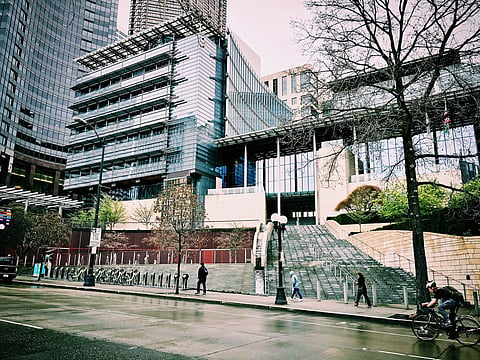Cold Weather Shelter Plan Illustrates Challenges With Encampment Elimination Proposals
by Erica C. Barnett
(This article originally appeared in PubliCola and has been reprinted under an agreement.)
As temperatures dipped below freezing Tuesday, Feb. 22, the King County Regional Homelessness Authority (KCHRA) announced the opening of a single, nighttime-only shelter for up to 96 single adults at City Hall. The shelter will open at 7 p.m. and close at 6:30 a.m. Two additional shelters are opening for young adults and unaccompanied youth — one in Rainier Beach and one at the Orion Center near downtown. (Details and updates, including information about shelters outside Seattle, are available on the KCRHA website.)
KCRHA spokeswoman Anne Martens said the authority has "a couple conversations still in motion based on provider capacity" for opening day centers on short notice, but for now, they're encouraging people to warm up in shopping malls and public libraries.
One reason short-term winter shelters are often underutilized, service providers say, is that people don't want to abandon their encampments to go to a place they'll have to leave first thing in the morning. Day centers can help alleviate this issue, but they work best when they're co-located with shelter, so that people don't have to pack up and walk to a different place during the day before returning to shelter at night.
This is the KCRHA's first time coordinating winter weather shelter since taking over responsibility for homeless services from the city, which eventually opened shelters in three locations — two in Seattle Center and one at City Hall — plus several daytime warming centers during the last winter weather emergency in December.
For now, the authority plans to keep the shelters open through Saturday, Feb. 26, when temperatures are expected to rise above freezing. To Alison Eisinger, director of the Seattle/King County Coalition on Homelessness, freezing-weather shelters are a wholly inadequate response to the crisis of unsheltered homelessness.
"I'm glad that people's consciences are pricked when the temperature dips, as they should be, but let's not kid ourselves — leaving people outside in 34-degree weather is equally bad for their health," Eisinger said. In January alone, at least 21 men died while living unsheltered in Seattle.
The location of the authority's single overnight shelter in downtown Seattle also highlights an obvious challenge for plans, announced last week, to reduce the number of people living in tents downtown to "functional zero": Downtown Seattle is the region's nexus for homeless services. Whether the goal is to provide meaningful shelter and housing or simply to move unsheltered people to sanctioned encampments elsewhere, placing services downtown means that people will come downtown to access services.
Speaking about the authority's "Pathway to Zero" plan last week, Marc Dones, CEO of the KCRHA, said that they believe it will be possible to reach "functional zero" homelessness downtown by first figuring out how many people come into downtown through "inflow" points like the King County Jail, Harborview, and other sources, then immediately working to connect them with resources elsewhere.
"The things that are going to contribute to inflow into the downtown core are going nowhere any time soon. I don't control them," Dones said. "My goal in the design of this work … was to say, 'How can we build that sustainable ecosystem that is able to quite literally meet new folks as they show up and begin to immediately triage and work to say, "Where are we going? What do you need? How can we make sure that you are able to get there?"'"
Eisinger said that neither "putting people into fenced areas" nor the authority's "Pathway to Zero" proposal constitutes a meaningful plan to address homelessness in downtown Seattle.
"Personally, having worked in Pioneer Square for 15 years, I am sick and tired of public officials abdicating their responsibility for genuine health, safety, and wellbeing for Seattle residents, including those who don't have homes, privacy, security, bathrooms, or garbage removal, and then coming up with half-considered at best proposals that they think will make downtown business interests happy," Eisinger said. "You know what makes a plan? Specific, well-considered, funded additional resources that meet the needs of people who have been abandoned by this city for years, including for the last two years during the COVID-19 pandemic."
Erica C. Barnett is a feminist, an urbanist, and an obsessive observer of politics, transportation, and the quotidian inner workings of City Hall.
Featured image is attributed to SDOT Photos (under a Creative Commons, CC BY-NC 2.0 license).
Before you move on to the next story …
The South Seattle Emerald™ is brought to you by Rainmakers. Rainmakers give recurring gifts at any amount. With around 1,000 Rainmakers, the Emerald™ is truly community-driven local media. Help us keep BIPOC-led media free and accessible.
If just half of our readers signed up to give $6 a month, we wouldn't have to fundraise for the rest of the year. Small amounts make a difference.
We cannot do this work without you. Become a Rainmaker today!
Help keep BIPOC-led, community-powered journalism free — become a Rainmaker today.


